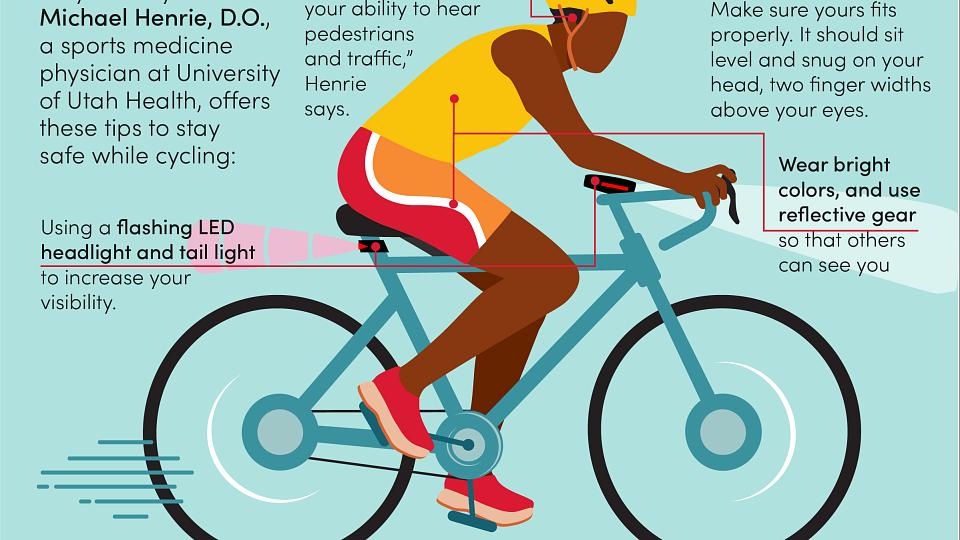
Interviewer: What are some of the common things that an emergency room physician sees after somebody wrecks their bike? I'm talking about a bicycle. That's next on The Scope.
Announcer: This is From the Frontlines, with emergency room physician Dr. Troy Madsen on The Scope.
Interviewer: Dr. Troy Madsen's an emergency room physician at University of Utah Health and I know this is kind of a broad question, but after somebody wrecks their bike, what are some common injuries that you see as a result of that in maybe hopes that we can prevent those from happening in the first place?
Dr. Madsen: Well, you know, it's a great question because springtime's right around the corner. Hopefully, it will get here soon. I keep telling myself it's almost here. But when springtime arrives, we started to see lots of bicycle-related injuries and it covers the full spectrum everything from scrapes, bumps, and bruises to serious, life-threatening injuries. So probably the most common thing we see are lacerations, people falling off their bike, getting in accidents, they cut their chin, their head, their arm, their elbow. We see fractures, lots of forearm fractures, people falling off bikes after accidents that come down on an outstretched hand or outstretched arm and break their forearm.
The most serious things we see are head injuries and these can be really serious injuries. Certainly, wearing a helmet is one of the best things you can do to prevent a head injury. But in terms of head injuries, we'll see bleeding in the head, certainly see facial fractures, nose fractures, things like that.
Interviewer: Let's go back and cover a couple of those. So let's start with head injuries since that's the most serious. So wearing a helmet, definitely good, can reduce the chance that you're going to get a head injury, can reduce the severity, I would imagine. Do you find though that people wearing a helmet sometimes think they're a little bulletproof and take bigger chances so the helmets can actually cause problems?
Dr. Madsen: Great question. I think that's probably true to some degree.
Interviewer: Sure.
Dr. Madsen: I think maybe people sometimes overestimate the value of a helmet. It's going to help but again, just think of your helmet as just a big piece of Styrofoam, essentially. It's going to cushion that fall but it's, you know, we will absolutely see cases of very serious head injuries in people who are wearing helmets.
Interviewer: Yeah. So you probably should pretend like you just don't have it even though you do.
Dr. Madsen: Sure.
Interviewer: You know, ride that is. So is there anything you can do to avoid head injuries if you got the helmet on? Anything you can watch out for beforehand?
Dr. Madsen: Well, the most serious injuries we see on bicycles are people who get hit by cars. So, you know, there's the whole defensive driving thing. You got to ride defensively as well. And you really, and I know, bicyclists know this and do this, but you absolutely to just expect the worse from the cars around you, expect they're going to run stop lights and stop signs, expect they're going to turn into you as they're making a right turn and you're coming up on the right side. Just expect it's going to happen.
Interviewer: Yeah.
Dr. Madsen: And personally, having, you know, previously ridden my bike to work, I can say it seemed like I saw everything and how many close calls were there, and I think every cyclist knows that. So you kind of have to expect it and watch for it and really be on the defensive.
Interviewer: Yeah, anticipate those things. What about, you know, you said arm injuries, people put their arms out. Is there a better way to fall?
Dr. Madsen: I wish I could say there was, but there's probably not.
Interviewer: You don't what it is. Okay.
Dr. Madsen: There's really not. That's probably your best option because you figure the other alternative would be just to come straight down on your side, you know, then that increases the risk of head injury when you do hit your side. Other things we see are a pneumothorax, where people will break a rib that punctures a lung, releasing air. That can be a much more serious thing. So, probably, that forearm injury is the best injury you can walk away with in that kind of generic. If you're coming down that hard.
Interviewer: Got you. And when do you know if it's bad enough to go to the ER?
Dr. Madsen: Well, you know, head injuries, if you've lost consciousness that's a reason to go to the ER. If you're having nausea or vomiting afterward, confusion, definitely reasons to go to the ER. Certainly, any injury in your legs where you can't bear weight, that's a reason to get checked out, get an X-ray. And then the forearm injuries, you know, usually, you're going to see a decent amount of swelling or some sort of deformity if it's broken. So again, reason to go to the ER and get checked out. Lacerations, if it's something that you're not comfortable just putting a Band-Aid on. If it's something where the edges are gaping open, you're probably going to need some stitches, again, ER or urgent care would be able to handle that.
Announcer: Have a question about a medical procedure? Want to learn more about a health condition? With over 2,000 interviews with our physicians and specialists, there’s a pretty good chance you’ll find what you want to know. Check it out at TheScopeRadio.com.


